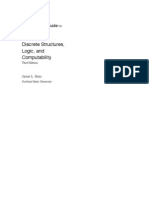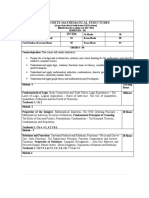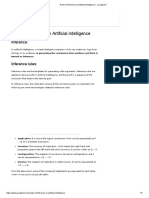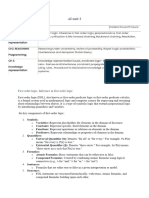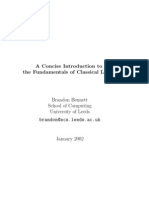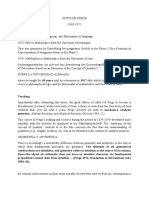Weekly planner Discrete Structures
Text Book
Kenneth H. Rosen, Discrete Mathematics and Its Applications, seventh Edition., McGraw-Hill.
Week Lectur Topics with suggested practice questions
# e
1 1 1.1 Propositional Logic (Q1 - 15 , Q24 - 28 (any 2), Q16 – 18, Q30, Q32 - 37 (any 2),
Q40 or 41,Q42)
2 1.2 Applications of Propositional Logic (Q 1-10)
1.3 Propositional Equivalences : Logical Equivalences,
2 3 1.3 Propositional Equivalences : Using De Morgan’s Laws Constructing New Logical
Equivalences, Propositional Satisfiability
(Q11,12,Q17-33,Q34,35,Q58-62(ANY OF TWO OR THREE PARTS))
4 1.4 Predicates and Quantifiers: Predicates, Quantifiers, Quantifiers with Restricted
Domains,
3 5 1.4 Logical Equivalences Involving Quantifiers, Negating Quantified Expressions,
Translating from English into Logical Expressions, Using Quantifiers in System
Specifications
Q1-10(ANY TWO),Q11-20(ANY TWO),Q21-29(ANY TWO),Q30-34(ANY
TWO),Q35-42,Q43-50(ANY TWO)
6 1.5 Nested Quantifiers, Translating Mathematical Statements into Statements
Involving Nested Quantifiers, Translating from Nested Quantifiers into English
4 7 1.5 Translating English Sentences into Logical Expressions, Negating Nested Quantifiers
Q. 6-8, 11, 16-18, 24-32 (any 2 questions),33-38 (any 2 questions ),39 0r 40,41-47 ( any
two questions )
8 1.6 Rules of Inference, Valid Arguments in Propositional Logic, Rules of Inference for
Propositional Logic, Using Rules of Inference to Build Arguments
5 9 1.6 Fallacies, Rules of Inference for Quantified Statements, Combining Rules of
Inference for Propositions and Quantified Statements. (1-10, 12, 14, 16, 17, 19, 21, 24,
28, 33,)
10 2.1, 2.2 and 2.3
6 11 2.5 Cardinality of sets. countable sets
12 uncountable sets (Question 1,3,6,9,10,12,16, 19,22, 34, 35)
9.1 Relations and Their Properties (all even numbered questions )
7 13 9.3 Representing Relations 1-22
9.4 definitions of reflexive and transitive closure (question 1-4)
14 9.5 equivalence relation (question 1-20, 25,31,32, 41, 42)
1.7 Proof Techniques (questions 1-15(any 5 questions), 18,20,22, 24,26,29,33, 37)
8 15 1.8 (questions 1-10)
5.1 Mathematical Induction
16 5.1 Mathematical Induction (Questions 1,2 any one out of all the below group 3,4 5,6,7,8
9,10,11 12 13-17 any 2 18,19 any 1 20,21 22,23 31-34 35-37 38,39)
5.2 Strong Induction
9 17 5.2 Strong Induction (questions 1-15 25,26)
4.1 Divisibility
18 4.1 Modular Arithmetic (questions 7,8,9, 13, 16, 19, 20 , 23, 25, 28, 30, 34, 46, 47)
4.3 Primes and Greatest Common Divisors, The Euclidean Algorithm,
10 19 4.3 gcds as Linear Combinations, BÉZOUT’S THEOREM ( questions 1,4, 6,14,17, 20,
24, 27, 30, 33, 35, 40)
4.4 Solving Congruences , The Chinese Remainder Theorem,
20 4.4 Fermat’s Little Theorem( Questions 1,5, 10, 12, 20, 24, 31,34,39)
11 21 6.1 The Basics of Counting 1-40(all even numbered questions ), 44, 47, 49, 53, 59
22 6.2 The Pigeonhole Principle (1-20 (odd questions ) , 23, 24, 35, 44 )
� 6.3 The Pigeonhole Principle1-38 (odd questions )
12 23 6.4 Binomial Coefficients and Identities (1, 13, 20, 22, 23, 27)
6.5 Generalized Permutations and Combinations (1,9,16,22,24,26, 27 36, 38, 39, 42, 44, 50)
24 Advanced counting techniques 8.1
Advanced counting techniques 8.2
13 25 8.1 (1, 4, 6, 7 )
8.2 (1,4,5,6, 21, 23, 25, 26)
26 Graphs 10.1 (1-20 )
10.2 (3, 4,5,6,8,10, (12-19 any three), 20, 23, 27, 35,)
14 27 10.3 (4, 5, 11,14,15, 18, 21, (34-44 any 4), 45, 55, 58)
28 Course review
